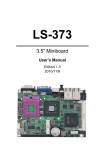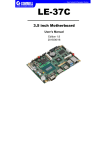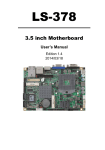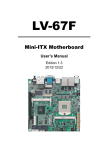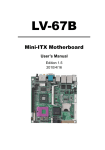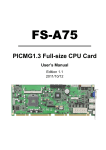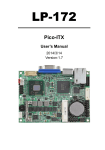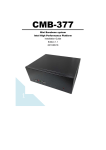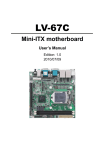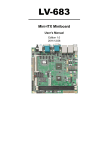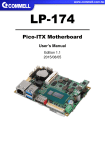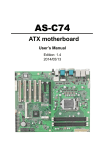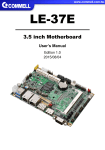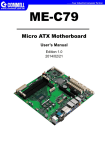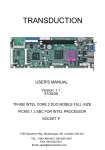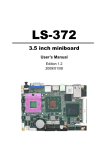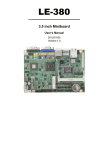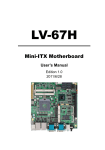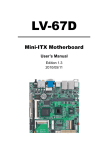Download LS-377 - minipc.jp
Transcript
LS-377 3.5 Miniboard User’s Manual Edition 1.1 2011/01/20 LS-377 User’s Manual Copyright Copyright 2010, all rights reserved. This document is copyrighted and all rights are reserved. The information in this document is subject to change without prior notice to make improvements to the products. This document contains proprietary information and protected by copyright. No part of this document may be reproduced, copied, or translated in any form or any means without prior written permission of the manufacturer. All trademarks and/or registered trademarks contains in this document are property of their respective owners. Disclaimer The company shall not be liable for any incidental or consequential damages resulting from the performance or use of this product. The company does not issue a warranty of any kind, express or implied, including without limitation implied warranties of merchantability or fitness for a particular purpose. The company has the right to revise the manual or include changes in the specifications of the product described within it at any time without notice and without obligation to notify any person of such revision or changes. Trademark All trademarks are the property of their respective holders. Any questions please visit our website at http://www.commell.com.tw -1- LS-377 User’s Manual Packing List: Please check the package content before you starting using the board. Hardware: LS-377 3.5’’ Miniboard x 1 Cable Kit: SATA Cable x 1 (OALSATA-L) DC Power Cable x 1 (OALDC-2) Audio Cable x 1 (OALPJ-HDUNB) COM Port Cable x 1 (OALES-BKU1NB) PS/2 Keyboard & Mouse Cable x 1 (OALPS2/MK) 1 to 3 Power Output Cable x 1 (OAL4P-2) SATA Power Cable x 1 (OAL4P-S1) USB Cable x 1 (OALUSBA-3) DVI Module With DVI Cable x 1 (BADPDVI-A + OALDVI-P) CPU Cooler x 1 (OHS-P-M-G) Printed Matters: Driver CD (Including User’s Manual) x 1 -2- LS-377 User’s Manual Index Chapter 1 <Introduction> .......................................................................................... 5 1.1 <Product Overview>..................................................................................... 5 1.2 <Product Specification>................................................................................ 6 1.3 <Mechanical Drawing>................................................................................. 7 1.4 <Block Diagram>.......................................................................................... 8 Chapter 2 <Hardware Setup>.................................................................................... 9 2.1 <Connector Location> .................................................................................. 9 2.2 <Jumper Location & Reference>................................................................ 11 2.3 <Connector Reference> ............................................................................. 13 2.3.1 <Internal Connectors> ................................................................... 13 2.3.2 <External Connectors> .................................................................. 13 2.4 <CPU and Memory Setup> ........................................................................ 14 2.4.1 <CPU Setup>................................................................................. 14 2.4.2 <Memory Setup> ........................................................................... 15 2.5 <CMOS Setup> .......................................................................................... 16 2.6 <Serial ATA Interface> ................................................................................ 17 2.7 <Ethernet Interface>................................................................................... 18 2.8 <Onboard Display Interface> ..................................................................... 19 2.8.1 <Analog Display>........................................................................... 19 2.8.2 <Digital Display> ............................................................................ 20 2.8.3 <DVI Interface>.............................................................................. 24 2.9 <Integrated Audio Interface> ...................................................................... 25 2.10 <GPIO and SMBUS Interface>................................................................. 27 2.11 <Power Supply> ....................................................................................... 28 2.11.1 <Power Input>.............................................................................. 28 2.13.2 <Power Output>........................................................................... 29 2.12 <Switch and Indicator> ............................................................................. 30 Chapter 3 <System Setup> ..................................................................................... 31 3.1 <Audio Configuration>................................................................................ 31 -3- LS-377 User’s Manual 3.2 <Display Properties Setting> ......................................................................32 Chapter 4 <BIOS Setup>..........................................................................................34 Appendix A <I/O Port Pin Assignment>..................................................................35 A.1 <Serial ATA Port> .......................................................................................35 A.2 <IrDA Port>.................................................................................................35 A.4 <Serial Port 2> ...........................................................................................35 A.5 <VGA Port> ................................................................................................36 A.6 <LAN Port>.................................................................................................36 A.7 < USB Interface >.......................................................................................36 Appendix B <Flash BIOS> .......................................................................................37 B.1 <Flash Tool>...............................................................................................37 B.2 <Flash BIOS Procedure> ...........................................................................37 Appendix C <System Resources> ..........................................................................38 C.1 <I/O Port Address Map>.............................................................................38 C.2 <Memory Address Map> ............................................................................40 C.3 <System DMA & IRQ Resources> .............................................................41 Appendix D <Programming GPIO’s> ......................................................................42 Appendix E <Programming Watchdog Timer > .....................................................43 Appendix F <How to setting RS-232/RS-422/RS-485>...........................................44 Contact Information .................................................................................................45 -4- LS-377 User’s Manual Chapter 1 <Introduction> 1.1 <Product Overview> LS-377Q the new generation of the 3.5 miniboard, supports Intel Core i7, Core i5 and Core i3 Processors and features Intel QM57 chipset, integrated HD Graphics, DDR3 memory, REALTEK High Definition Audio, Serial ATA and 1 x Intel Gigabit LAN. Intel Arrandale and Clarkfield Processor The board supports Intel Core i7, Core i5 and Core i3 Processors with, 8MB Intel® Smart Cache, to provide more powerful performance than before. New features for Intel QM57 chipset The board integrates Intel QM57 chipset, to provide new generation of the mobile solution, supports integrated HD Graphics, DDR3 800/1066 MHz memory, built-in high speed mass storage interface of Serial ATA, High Definition Audio with 7.1 channels surrounding sound. All in One multimedia solution Based on Intel QM57 chipset, the board provides high performance onboard graphics, 24-bit dual channel LVDS interface, DVI and 7.1 channels High Definition Audio, to meet the very requirement of the multimedia application. Flexible Extension Interface The board provides, one mini-PCIE socket, one mini-PCI socket. -5- LS-377 User’s Manual 1.2 <Product Specification> General Specification Form Factor 3.5’’ Miniboard CPU Intel® Core™ i7, Core™ i5, Core™ i3, Celeron®, and Pentium® Mobile Processor Package type: rPGA988A Memory 1 x DDRIII SO-DIMM 800/1066 MHz up to 4GB Chipset Intel QM57 Real Time Clock Chipset integrated RTC with onboard lithium battery Watchdog Timer Generates a system reset with internal timer for 1min/s ~255min/s Power Management Supports ACPI 2.0 compliant, Serial ATA Interface 2 x serial ATAII interface with 300MB/s transfer rate VGA Interface Intel integrated extreme GMA 4500MHD (Graphic Media Accelerator) Technology LVDS Interface Onboard 24-bit dual channel LVDS connector with +3.3V/+5V/+12V supply DVI Interface DVI interface Audio Interface Realtek ALC888 HD Audio LAN Interface 1 x Intel 82574L Gigabit LAN GPIO Interface Onboard programmable 8-bit Digital I/O interface Extended Interface 1 x Mini PCIE socket, 1 x Mini PCI socket to support Mini PCI Type IIIA Internal I/O Port 1 x RS232/422/485, 1 x SMBUS, 1 x GPIO port, 4 x USB ports, 1 x IrDA, 2 x Serial ATA, 1x LVDS, 1 x DIO, 1x LCD inverter connector, 1 x Audio connector and 1 x DCOUT connector External I/O Port 1 x PS/2 Keyboard/Mouse Port, 1 x RJ45 LAN ports, 1 x VGA port, 2 x USB2.0 ports, 1 x RS232 port Power Requirement 9~24V full range DC Input Dimension 146mm x 101mm Temperature Operating within 0~60 centigrade Storage within –20~85 centigrade Ordering Code LS-377Q Intel Arrandale + QM57 Onboard VGA, LVDS, LAN, USB2.0, HD Audio, SATA, SMBUS, Mini PCI and PCIE mini card MPX-7202 PCI Express mini card supports 2 x USB 3.0 provides up to 4.8Gbps of transferring rate. The specifications may be different as the actual production. For further product information please visit the website at http://www.commell.com.tw TU -6 - UT LS-377 User’s Manual 1.3 <Mechanical Drawing> Unit: inch -7 - LS-377 User’s Manual 1.4 <Block Diagram> Intel® Core™ i7, Core™ i5, Core™ i3, Celeron®, and Pentium® Mobile Processor 1 x 204-pin DDR3 SO-DIMM 800/1066 MHz up to 4GB 1 x CRT 1 x LVDS 1 x PCI Express mini card QM57 1 x Mini-PCI 1 x DVI 6 x USB 2.0 2 x Serial ATA 1 x Intel 82574L ALC888 HD Audio 1 x RS232/422/485 IO W83627DHG-P 1 x COM & GPIO & IrDA -8 - LS-377 User’s Manual Chapter 2 <Hardware Setup> 2.1 <Connector Location> DVI JFRNT IR Mini Card USB COM2 HD Audio DIO SYSFAN CPUFAN DC_OUT Mini-PCI LVDS SATA DC_IN CN_INV SO-DIMM -9 - CD_IN LS-377 User’s Manual COM CRT -10- PS/2 USB LAN LS-377 User’s Manual 2.2 <Jumper Location & Reference> Jumper JRTC JVLCD JAT JP1 JP2 Function CMOS Operating/Clear Setting Panel Voltage Setting Power mode select Com1 Voltage Setting Com2 Voltage Setting JP1/JP2 JRTC JAT JVLCD -11- LS-377 User’s Manual Jumper: JAT Type: onboard 3-pin header Power Mode JAT AT Mode 1-2 ATX Mode 2-3 Default setting: ATX Mode 3 1 Jumper: JP1 (COM 1) Type: onboard 6-pin header Power Mode JP1 Pin1 with 5V signal 1-2,5-6 Pin9 with 12V signal 3-4,5-6 Default setting: 5-6 2 6 1 5 Jumper: JP2 (COM 2) Type: onboard 6-pin header Power Mode JP2 Pin1 with 5V signal 1-2,5-6 Pin9 with 12V signal 3-4,5-6 Default setting: 5-6 -12- 2 6 1 5 LS-377 User’s Manual 2.3 <Connector Reference> 2.3.1 <Internal Connectors> Connector CPU SO-DIMM SATA1/2 DC_IN CN_AUDIO CD_IN CN_DIO CN_USB 1/2 CPUFAN SYSFAN CN_LVDS CN_INV CN_IR JFRNT Mini-PCI Mini-PCIE CN_COM2 JAT Function Socket rPGA989 for PGA988 CPU 204 -pin DDR3 SO-DIMM socket 7-pin Serial ATA connector DC 9~24V input connector 5 x 2-pin audio connector 4-pin CD-ROM audio input connector 6 x 2-pin digital I/O connector 5 x 2-pin USB connector 4-pin CPU cooler fan connector 3-pin system cooler fan connector 20 x 2-pin LVDS connector 5-pin LCD inverter connector 5-pin IrDA connector 10-pin front panel switch/indicator connector 124-pin Mini-PCI socket Type IIIA 52-pin Mini-PCIE socket 9-pin RS422/485/232 Power mode select Remark 2.3.2 <External Connectors> Connector RJ45 COM1 + CRT PS/2 USB Function RJ45 LAN connector COM1 Connect DB15 and analog VGA connector PS/2 keyboard and mouse connector 2 x USB -13- Remark LS-377 User’s Manual 2.4 <CPU and Memory Setup> 2.4.1 <CPU Setup> The board comes with the socket rPGA989 for Intel Arrandale and Clarkfield Processor, Intel® Smart 8MB Cache. Please follow the instruction to install the CPU properly. Unlock way 1. Use the flat-type screw Check point drive to unlock the CPU socket 2. Follow the pin direction to install the processor on the socket 4. CPU socket has 989 pins 3. Lock the socket Socket-M CPU Check point -14- LS-377 User’s Manual 2.4.2 <Memory Setup> The board provides 1 x 204-pin DDR3 SO-DIMM to support 800/1066MHz DDR3 memory module up to 4GB. SO-DIMM -15- LS-377 User’s Manual 2.5 <CMOS Setup> The board’s data of CMOS can be setting in BIOS. If the board refuses to boot due to inappropriate CMOS settings, here is how to proceed to clear (reset) the CMOS to its default values. Jumper: JRTC Type: Onboard 3-pin jumper JRTC Mode 1-2 Clear CMOS 2-3 Normal Operation Default setting: 2-3 1 3 JRTC -16- LS-377 User’s Manual 2.6 <Serial ATA Interface> Based on Intel QM57, the board provides four Serial ATAII interfaces with up to 300MB/s of transfer rate. SATA Port 1/2 -17- LS-377 User’s Manual 2.7 <Ethernet Interface> The board integrates with one Intel PCI Express Gigabit Ethernet controllers, as the PCI Express x 1 can speed up to 250MB/s of transfer rate instead of late PCI bus with 133MB/s of transfer rate. The Intel Gigabit Ethernet supports triple speed of 10/100/1000Base-T, with IEEE802.3 compliance and Wake-On-LAN supported. RJ45 LAN connector -18- LS-377 User’s Manual 2.8 <Onboard Display Interface> Based on Intel Arrandale CPU with built-in HD Graphic, the board provides one DB15 connector on real external I/O port, one 40-pin LVDS interface with 5-pin LCD backlight inverter connector optional or Secondary CRT connector and provides optional 26-pin DVI interface. The board provides dual display function with clone mode and extended desktop mode for CRT, LCD and DVI. 2.8.1 <Analog Display> Please connect your CRT or LCD monitor with DB15 male connector to the onboard DB15 female connector on rear I/O port or optional Secondary CRT connect. CRT -19- LS-377 User’s Manual 2.8.2 <Digital Display> The board provides one 40-pin LVDS connector for 24-bit single/dual channel panels, supports up to 1920 x 1200 (UXGA) resolution, with one LCD backlight inverter connector and one jumper for panel voltage setting. 39 40 1 2 CN_LVDS 1 5 CN_INV Effective patterns of connection: 1-2 / 3-4 / 5-6 2 4 6 1 3 5 Warning: others cause damages -20- 2 6 1 5 JVLCD LS-377 User’s Manual Connector: CN_INV Type: 5-pin LVDS Power Header Connector: JVLCD Type: 6-pin Power select Header Pin Description 1 +12V 2 Reserved (Note) 3 GND 4 GND 5 ENABKL Note: Reserved for MB internal test Please treat it as NC. Pin Description 1-2 LCDVCC (3.3V) 3-4 LCDVCC (5V) 5-6 LCDVCC (12V) Default: 1-2 Connector: CN_LVDS Type: onboard 40-pin connector for LVDS connector Connector model: HIROSE DF13-40DP-1.25V Pin 2 4 6 8 10 12 14 16 18 20 22 24 26 28 30 32 34 36 38 40 Signal LCDVCC GND ATX0ATX0+ GND ATX1ATX1+ GND ATX2ATX2+ GND ACLKACLK+ GND ATX3ATX3+ GND DDCPCLK DDCPDATA N/C -21- Pin 1 3 5 7 9 11 13 15 17 19 21 23 25 27 29 31 33 35 37 39 Signal LCDVCC GND BTX0BTX0+ GND BTX1BTX1+ GND BTX2BTX2+ GND BTX3BTX3+ GND BCLKBCLK+ GND N/C N/C N/C LS-377 User’s Manual To setup the LCD, you need the component below: 1. A panel with LVDS interfaces. 2. An inverter for panel’s backlight power. 3. A LCD cable and an inverter cable. For the cables, please follow the pin assignment of the connector to make a cable, because every panel has its own pin assignment, so we do not provide a standard cable; please find a local cable manufacture to make cables. LCD Installation Guide: 1. Preparing the LS-377, LCD panel and the backlight inverter. 2. Please check the datasheet of the panel to see the voltage of the panel, and set the jumper JVLCD to +12V or +5V or +3.3V. 3. You would need a LVDS type cable. Panel side Board side For sample illustrator only 4. To connect all of the devices well. -22- LS-377 User’s Manual After setup the devices well, you need to select the LCD panel type in the BIOS. The panel type mapping is list below: BIOS panel type selection form (BIOS Version:1.0) 18-bit Single channel 24-bit Dual channel NO. Output format NO. 1 640 x 480 11 1280 x 768 2 800 x 480 12 1280 x 1024 3 800 x 600 13 1600 x 1200 4 1024 x 768 14 1920 x 1080 5 1280 x 800 15 1920 x 1200 18-bit Dual channel 6 1280 x 768 24-bit Single channel 7 1024 x 768 8 1280 x 768 9 1280 x 800 10 1366 x 768 -23- Output format LS-377 User’s Manual 2.8.3 <DVI Interface> The board provides an option 26-pin DVI interface Connector: CN_DVI Connector type: 26-pin header connector (pitch = 2.00mm) Pin Number 1 3 5 7 9 11 13 15 17 19 21 23 25 Assignment TX1+ Ground TXC+ Ground N/C TX2+ Ground TX0+ N/C DDCDATA GND N/C N/C Pin Number 2 4 6 8 10 12 14 16 18 20 22 24 26 Assignment TX1Ground TXC+5V N/C TX2Ground TX0HPDET DDCCLK N/C N/C N/C 26 25 2 1 DVI -24- LS-377 User’s Manual 2.9 <Integrated Audio Interface> The board integrates onboard audio interface with REALTEK ALC888 codec, with Intel next generation of audio standard as High Definition Audio, it offers more sound and other advantages than former ALC888 audio compliance. The main specifications of ALC888 are: z High-performance DACs with 100dB S/N ratio z 8 DAC channels support 16/20/24-bit PCM format for 7.1 audio solution z 16/20/24-bit S/PDIF-OUT supports 44.1K/48K/96kHz sample rate z Compatible with ALC888 z Meets Microsoft WHQL/WLP 2.0 audio requirements The board provides 7.1 channels audio phone jacks on rear I/O port, and Line-in/MIC-in ports for front I/O panel through optional cable. 1 2 10 1 9 CN_Audio 4 1 CD_IN -25- LS-377 User’s Manual Connector: CN_AUDIO Type: 10-pin (2 x 5) header (pitch = 2.54mm) Pin Description Pin 1 MIC_L 2 3 MIC_R 4 5 Speaker_R 6 7 SENSE 8 9 Speaker_L 10 Connector: CDIN Type: 4-pin header (pitch = 2.54mm) Pin Description 1 CD – Left 2 Ground 3 Ground 4 CD – Right -26- 2 10 1 9 Description Ground Reserve MIC Detect N/C Speaker Detect 4 1 LS-377 User’s Manual 2.10 <GPIO and SMBUS Interface> The board provides a programmable 8-bit digital I/O interface; you can use this general purpose I/O port for system control like POS or KIOSK. Connector: CN_DIO Type: 12-pin (6 x 2) header (pitch = 2.0mm) Pin Description Pin 1 Ground 2 3 GP10 4 5 GP11 6 7 GP12 8 9 GP13 10 11 VCC 12 Description Ground GP14 GP15 GP16 GP17 +12V Connector: CN_SMBUS Type: 5-pin header for SMBUS Ports Pin 1 2 3 4 5 12 Description VCC N/C SMBDATA SMBCLK Ground SMBUS 11 2 1 CN_DIO -27- LS-377 User’s Manual 2.11 <Power Supply> 2.11.1 <Power Input> The board requires onboard 4-pin DC-input connector voltage range is from 9V to 24V, or onboard 20-pin ATX2.0, for the input current, please take a reference of the power consumption report on appendix. Connector: DC_IN Type: 4-pin DC power connector Pin Description 1 Ground 3 +9~24V Pin 2 4 DC_IN 3 1 4 2 -28- Description Ground +9~24V LS-377 User’s Manual 2.13.2 <Power Output> Connector: DC_OUT Type: 4-pin connector for +5V/+12V output Pin 1 2 3 4 Description +12V GND GND +5V Note: Maximum output current 12V/1A, 5V/1A 4 1 -29- LS-377 User’s Manual 2.12 <Switch and Indicator> The JFRNT provides front control panel of the board, such as power button, reset and beeper, etc. Please check well before you connecting the cables on the chassis. Connector: JFRNT Type: onboard 10-pin (2 x 5) 2.54-pitch header Function Signal 1 2 PWRBT+ Speaker SPK- 3 4 SPK+ HDD LED HLED- 5 6 HLED+ GND 7 8 PWLED+ Reset- 9 10 GND Power LED Reset 1 Signal PWRBT- Power 2 PIN JFRNT 10 9 -30- LS-377 User’s Manual Chapter 3 <System Setup> 3.1 <Audio Configuration> The board integrates Intel® QM57 with REALTEK® ALC888 codec. It can support 2-channel or 7.1 channel sound under system configuration. Please follow the steps below to setup your sound system. 1. Install REALTEK HD Audio driver. 2. Lunch the control panel and Sound Effect Manager. 3. Select Speaker Configuration -31- LS-377 User’s Manual 3.2 <Display Properties Setting> Based on Intel GM45 GMCH with GMA 4500MHD (Graphic Media Accelerator), the board supports two DACs for display device as different resolution and color bit. Please install the Intel Graphic Driver before you starting setup display devices. 1. Click right button on the desktop to lunch display properties 2. Click Advanced button for more specificity setup. Click Graphics Properties... for advanced setup -32- LS-377 User’s Manual 4. This setup options can let you define each device settings. Click Monitor to setup the CRT monitor for Resolution and Refresh Rate Click Intel® Dual Display Clone to setup the dual display mode as same screen -33- LS-377 User’s Manual Chapter 4 <BIOS Setup> The motherboard uses the Phoenix BIOS for the system configuration. The Phoenix BIOS in the single board computer is a customized version of the industrial standard BIOS for IBM PC AT-compatible computers. It supports Intel x86 and compatible CPU architecture based processors and computers. The BIOS provides critical low-level support for the system central processing, memory and I/O sub-systems. The BIOS setup program of the single board computer let the customers modify the basic configuration setting. The settings are stored in a dedicated battery-backed memory, NVRAM, retains the information when the power is turned off. If the battery runs out of the power, then the settings of BIOS will come back to the default setting. The BIOS section of the manual is subject to change without notice and is provided here for reference purpose only. The settings and configurations of the BIOS are current at the time of print, and therefore they may not be exactly the same as that displayed on your screen. To activate CMOS Setup program, press <DEL> key immediately after you turn on the system. The following message “Press DEL to enter SETUP” should appear in the lower left hand corner of your screen. When you enter the CMOS Setup Utility, the Main Menu will be displayed as Figure 4-1. You can use arrow keys to select your function, press <Enter> key to accept the selection and enter the sub-menu. Figure 4-1 CMOS Setup Utility Main Screen -34- LS-377 User’s Manual Appendix A <I/O Port Pin Assignment> A.1 <Serial ATA Port> Connector: SATA1/2 Type: 7-pin wafer connector 1 2 3 7 4 5 1 6 7 GND RSATA_TXP1 RSATA_TXN1 GND RSATA_RXN1 RSATA_RXP1 GND A.2 <IrDA Port> Connector: CN_IR Type: 5-pin header for SIR Ports Pin 1 2 3 4 5 JCSEL1 must jump to “SIR” Description VCC N/C IRRX Ground IRTX 1 5 1 A.3 <Serial Port 1> Connector: COM1 Type: 9-pin D-sub male connector on bracket Pin Description Pin 1 DCD6 2 SIN7 3 SO8 4 DTR9 5 Ground A.4 <Serial Port 2> Connector: CN_COM2 Type: 9-pin header connector on bracket Pin Description Pin 1 DCD/422TX-/485 6 2 RXD/422TX+/485+ 7 3 SO- /422RX+ 8 4 DTR- /422RX9 5 Ground -35- 5 6 9 Description DSR RTS CTS RI 2 10 1 9 Description DSR RTS CTS RI LS-377 User’s Manual A.5 <VGA Port> 5 Connector: CRT Type: 15-pin D-sub female connector on bracket Pin Description Pin Description 1 RED 6 Ground 2 GREEN 7 Ground 3 BLUE 8 Ground 4 N/C 9 N/C 5 Ground 10 Ground 1 10 6 15 Pin 11 12 13 14 15 11 Description N/C DDCDA HSYNC VSYNC DDCCLK A.6 <LAN Port> Connector: RJ45 8 1 Type: RJ45 connector with LED on bracket Pin 1 2 3 4 5 6 7 8 Description TRD0+ TRD0- TRD1+ TRD2+ TRD2- TRD1- TRD3+ TRD3- A.7 < USB Interface > 2 Connector: CN_USB 3/4 Type: 10-pin (5 x 2) header for dual USB Ports Pin Description Pin 1 VCC 2 3 Data04 5 Data0+ 6 7 Ground 8 9 Ground 10 1 9 Description VCC Data1Data1+ Ground N/C A.8 < PS2 Port > The PS/2 connector supports standard PS/2 keyboard directly or both PS/2 keyboard and mouse through for PS/2 Y-cable. 2 1 4 Connector: PS2 Type: 6-pin Mini-DIN connector on bracket 3 6 5 Pin 1 2 3 4 5 6 Description KBCLK MSCLK GROUND VCC KBDATA MSDATA -36- LS-377 User’s Manual Appendix B <Flash BIOS> B.1 <Flash Tool> The board is based on Phoenix BIOS and can be updated easily by the BIOS auto flash tool. You can download the tool online at the address below: http://www.phoenix.com/en/home/ http://www.commell.com.tw/Support/Support_SBC.htm File name of the tool is “Phlash16.exe”, it’s the utility that can write the data into the BIOS flash ship and update the BIOS. B.2 <Flash BIOS Procedure> 1. Please make a bootable floppy disk. 2. Get the last .bin files you want to update and copy it into the disk. 3. Copy Phlash16.exe to the disk. 4. Power on the system and flash the BIOS. (Example: C:/Phlash16 XXX.ROM) 5. Restart the system. Any question about the BIOS re-flash please contact your distributors or visit the web-site at below: http://www.commell.com.tw/support/support.htm -37- LS-377 User’s Manual Appendix C <System Resources> C.1 <I/O Port Address Map> -38- LS-377 User’s Manual -39- LS-377 User’s Manual C.2 <Memory Address Map> -40- LS-377 User’s Manual C.3 <System DMA & IRQ Resources> DMA: IRQ: -41- LS-377 User’s Manual Appendix D <Programming GPIO’s> The GPIO’can be programmed with the MSDOS debug program using simple IN/OUT commands.The following lines show an example how to do this. GPIO0…..GPIO7 bit0……bit7 -o 2 E 87 ;enter configuration -o 2E 87 -o 2E 07 -o 2F 09 ;enale GPIO function -o 2E 30 -o 2F 02 ;enable GPIO configuration -o 2E F0 -o 2F xx ;set GPIO as input/output; set ‘1’ for input,’0’for output -o 2E F1 -o 2F xx ;if set GPIO’s as output,in this register its value can be set Optional : -o 2E F2 -o 2F xx ; Data inversion register ; ‘1’ inverts the current valus of the bits ,’0’ leaves them as they are -o 2E 30 -o 2F 01 ; active GPIO’s For further information ,please refer to Winbond W83627DHG datasheet. -42- LS-377 User’s Manual Appendix E <Programming Watchdog Timer > The watchdog timer makes the system auto-reset while it stops to work for a period. The integrated watchdog timer can be setup as system reset mode by program. Timeout Value Range - 1 to 255 - Second or Minute Program Sample Watchdog timer setup as system reset with 5 second of timeout 2E, 87 2E, 87 2E, 07 2F, 08 Logical Device 8 2E, 30 Activate 2F, 01 2E, F5 Set as Second* 2F, 00 2E, F6 Set as 5 2F, 05 * Minute: bit 3 = 0; Second: bit 3 = 1 You can select Timer setting in the BIOS, after setting the time options, the system will reset according to the period of your selection. -43- LS-377 User’s Manual Appendix F <How to setting RS-232/RS-422/RS-485> Function JCSEL2 JCSEL1 IrDA RS-422 RS-485 RS-232 2 8 2 12 1 7 1 11 JCSEL1 JCSEL2 -44- LS-377 User’s Manual Contact Information Any advice or comment about our products and service, or anything we can help you please don’t hesitate to contact with us. We will do our best to support you for your products, project a business. Taiwan Commate Computer Inc. Address 19F, No. 94, Sec. 1, Shin Tai Wu Rd., Shi Chih Taipei Hsien, Taiwan TEL +886-2-26963909 FAX +886-2-26963911 Website http://www.commell.com.tw E-Mail [email protected] (General Information) [email protected] (Technical Support) Commell is a brand name of Taiwan commate computer Inc. -45-















































